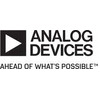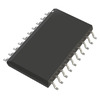Manufacturer Part Number
AD7805BRS
Manufacturer
analog-devices
Introduction
AD7805BRS is a high-performance, quad 10-bit digital-to-analog converter (DAC) designed for data acquisition and control applications.
Product Features and Performance
Quad 10-bit D/A converters
Settling Time: 4µs
Buffered voltage output
No differential output
Parallel data interface
Supports external and internal reference
Operating temperature range: -40°C ~ 85°C
Surface Mount package: 28-SSOP
Product Advantages
High integration with four DACs in one chip enhances system design compactness.
Fast settling time ensures quick response in dynamic systems.
Flexibility in using either external or internal reference based on precision needs.
Wide operating temperature range makes it suitable for industrial applications.
Key Technical Parameters
Number of Bits: 10
Number of D/A Converters: 4
Settling Time: 4µs
Output Type: Voltage Buffered
Data Interface: Parallel
Reference Type: External, Internal
Voltage Supply, Analog: 3V ~ 5.5V
Voltage Supply, Digital: 3V ~ 5.5V
INL/DNL (LSB): ±3 (Max), ±0.125
Quality and Safety Features
Rigorous testing ensures reliable performance under specified operating conditions.
Compatibility
Compatible with a wide range of microcontrollers and digital systems due to its parallel data interface and flexible supply voltage requirements.
Application Areas
Automated test equipment
Industrial control systems
Data acquisition systems
Digital signal processing
Product Lifecycle
Obsolete: This product is no longer being manufactured and may have limited or no availability of replacements or upgrades.
Several Key Reasons to Choose This Product
Compact design with four high-quality DACs reduces system footprint and complexity.
Fast settling time allows for quick data conversion and processing, ideal for high-speed systems.
Flexibility with reference selection (external or internal) accommodates various precision requirements easily.
The product's wide operating temperature range supports deployment in harsh industrial environments.
Despite being obsolete, its proven performance makes it a suitable choice for systems not requiring the newest technology or for maintenance of existing installations where compatibility is critical.





 AD7805BRS-REEL7ADI (Analog Devices, Inc.)
AD7805BRS-REEL7ADI (Analog Devices, Inc.) AD7801BRZAnalog Devices Inc.IC DAC 8BIT V-OUT 20SOIC
AD7801BRZAnalog Devices Inc.IC DAC 8BIT V-OUT 20SOIC AD7805CR-REELAnD Cable Products
AD7805CR-REELAnD Cable Products AD7804BR-REELAnalog Devices Inc.IC DAC 10BIT V-OUT 16SOIC
AD7804BR-REELAnalog Devices Inc.IC DAC 10BIT V-OUT 16SOIC